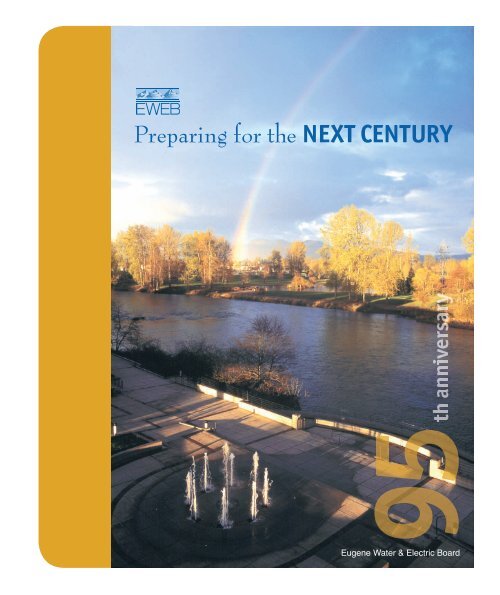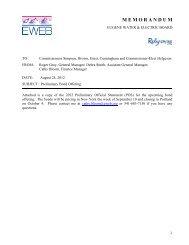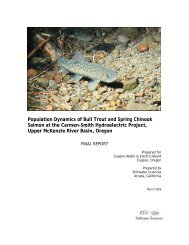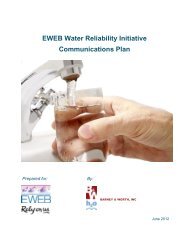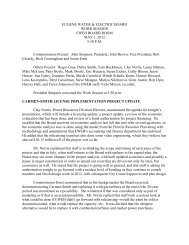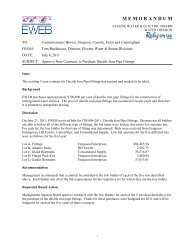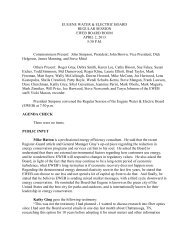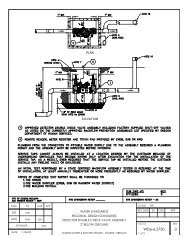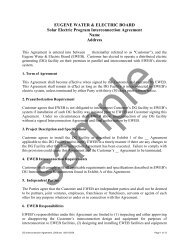Preparing for the NEXT CENTURY - Eugene Water & Electric Board
Preparing for the NEXT CENTURY - Eugene Water & Electric Board
Preparing for the NEXT CENTURY - Eugene Water & Electric Board
You also want an ePaper? Increase the reach of your titles
YUMPU automatically turns print PDFs into web optimized ePapers that Google loves.
<strong>Preparing</strong> <strong>for</strong> <strong>the</strong> <strong>NEXT</strong> <strong>CENTURY</strong><br />
<strong>Eugene</strong> <strong>Water</strong> & <strong>Electric</strong> <strong>Board</strong>
2 EWEB: PREPARING FOR THE <strong>NEXT</strong> <strong>CENTURY</strong><br />
EWEB: Where history<br />
and <strong>the</strong> future meet<br />
EWEB headquarters along <strong>the</strong> Willamette River.<br />
BRYAN WESEL<br />
Focus on <strong>the</strong> future.<br />
That’s been a hallmark of <strong>the</strong> <strong>Eugene</strong><br />
<strong>Water</strong> & <strong>Electric</strong> <strong>Board</strong> during its 95-year<br />
history. It was true during <strong>the</strong> first meeting<br />
of <strong>the</strong> <strong>Eugene</strong> <strong>Water</strong> <strong>Board</strong> in a downtown<br />
storefront in 1911, when civic leaders<br />
talked about<br />
how to utilize<br />
surplus<br />
electricity<br />
from <strong>the</strong><br />
newly<br />
completed<br />
Walterville<br />
Power Plant to run <strong>the</strong> city’s street lights.<br />
It remains <strong>the</strong> primary focus today.<br />
As EWEB marks its 95th year in 2006, <strong>the</strong><br />
utility’s staff and elected commissioners<br />
are not dwelling on <strong>the</strong> past. Instead,<br />
<strong>the</strong>y are preparing <strong>for</strong> <strong>the</strong> next century of<br />
operation as Oregon’s largest citizen-owned<br />
municipal utility.<br />
Several important initiatives are under<br />
way that will ensure EWEB remains a wellrun<br />
and efficient public utility with reliable<br />
electricity, excellent water and innovative<br />
services that provide value <strong>for</strong> each dollar<br />
spent by <strong>the</strong> utility’s 85,000 customerowners.<br />
“The next few years will be a critical<br />
time <strong>for</strong> EWEB,” says General Manager<br />
Randy Berggren. “EWEB has a long<br />
history of serving <strong>the</strong> public good, and<br />
<strong>the</strong> initiatives we are undertaking now<br />
will serve our customers <strong>for</strong> <strong>the</strong> next<br />
100 years with <strong>the</strong><br />
same ethic of public<br />
ownership, accountability,<br />
service, innovation and<br />
responsiveness.”<br />
Most notable on<br />
this list of initiatives is<br />
relocation of EWEB’s field<br />
operations to a new site in west <strong>Eugene</strong>.<br />
The utility’s administrative staff will<br />
remain in <strong>the</strong> current headquarters building<br />
along <strong>the</strong> Willamette River. But as early as<br />
next year, EWEB will begin construction<br />
of a new water and electric operations<br />
building, vehicle shops and o<strong>the</strong>r facilities<br />
to serve <strong>the</strong> engineers and field crews who<br />
keep <strong>the</strong> lights on and water coming out of<br />
<strong>the</strong> tap (See story, Page 5).<br />
This special section is intended to give<br />
readers of The Register-Guard an overview<br />
of <strong>the</strong>se major initiatives, along with a<br />
strong dose of EWEB’s rich history <strong>for</strong><br />
perspective.<br />
Some of <strong>the</strong> o<strong>the</strong>r initiatives and<br />
programs highlighted in this section are:<br />
■ On <strong>the</strong> heels of a new operating license<br />
<strong>for</strong> EWEB's two oldest power plants,<br />
Leaburg and Walterville, <strong>the</strong> utility will<br />
submit a license renewal application<br />
in November <strong>for</strong> its largest source of<br />
electricity, <strong>the</strong> Carmen-Smith Hydroelectric<br />
Project. Relicensing Carmen-Smith in 2008<br />
will ensure that EWEB customers continue<br />
to enjoy a reliable source of lower-cost<br />
electricity.<br />
■ EWEB continues to acquire wind power<br />
and o<strong>the</strong>r sources of clean, renewable<br />
energy. In 1999, EWEB became <strong>the</strong> first<br />
public utility in Oregon to build a wind<br />
farm and offer an innovative “windpower”<br />
option <strong>for</strong> customers. The utility has<br />
signed contracts to purchase additional<br />
windpower, is investing<br />
in new “fish-friendly”<br />
hydropower and soon<br />
may add geo<strong>the</strong>rmal<br />
power to its "portfolio"<br />
of energy sources.<br />
■ Thirty years ago,<br />
EWEB's leadership<br />
launched an era of energy<br />
conservation in <strong>the</strong> Pacific
EWEB: PREPARING FOR THE <strong>NEXT</strong> <strong>CENTURY</strong> 3<br />
“EWEB has a long history of serving <strong>the</strong> public good, and <strong>the</strong><br />
initiatives we are undertaking now will serve our customers<br />
<strong>for</strong> <strong>the</strong> next 100 years with <strong>the</strong> same ethic of public ownership,<br />
accountability, service, innovation and responsiveness.”<br />
– EWEB General Manager Randy Berggren<br />
Northwest. Today, 5 percent of electric<br />
revenues are invested back into <strong>the</strong><br />
community to help customers reduce<br />
consumption through conservation and<br />
energy efficiencies. Customers now save<br />
more than 50 megawatts of electricity<br />
– and tens of millions of dollars on <strong>the</strong>ir<br />
combined electric bills – each and every<br />
year.<br />
■ Customers are benefiting from a steppedup<br />
investment in making <strong>the</strong> electric and<br />
water systems more reliable. This includes<br />
an additional $7 million a year to improve<br />
aging poles, wires and o<strong>the</strong>r electric<br />
facilities, as well as planned increases in<br />
capital spending to rebuild aging water<br />
lines and reservoirs, and improve <strong>the</strong> water<br />
intake on <strong>the</strong> McKenzie River.<br />
■ EWEB is building on <strong>the</strong> strength<br />
of its work <strong>for</strong>ce in a number of ways.<br />
With nearly half of <strong>the</strong> utility's current<br />
employees eligible to retire within <strong>the</strong> next<br />
five years, EWEB is devoting resources to<br />
train <strong>the</strong> next generation of leaders.<br />
■ Ninety-five years ago, <strong>the</strong> citizens of<br />
<strong>Eugene</strong> created <strong>the</strong>ir own municipal utility<br />
to ensure <strong>the</strong> safety and health of <strong>the</strong> water<br />
supply. Since <strong>the</strong>n, water quality has been<br />
a top priority <strong>for</strong> EWEB. In recent years,<br />
EWEB has increased its ef<strong>for</strong>ts to protect<br />
our water supply, <strong>the</strong> McKenzie River.<br />
By <strong>the</strong> time EWEB's 100th anniversary<br />
rolls around in 2011, many of <strong>the</strong>se<br />
initiatives will be completed or well under<br />
way. Recognizing that <strong>the</strong>re's a need to<br />
keep planning – and acting – <strong>for</strong> <strong>the</strong> future<br />
Bill payment station, circa 1955.<br />
is what has given EWEB a reputation<br />
as a utility that gets things done with a<br />
high degree of efficiency. Or, as Norman<br />
Stone said in his 1986 book “Bountiful<br />
McKenzie:”<br />
“Over many years EWEB has tended<br />
to function in a light-calvary mode. It has<br />
avoided <strong>the</strong> pitfall of becoming a sluggish<br />
bureaucracy. It has moved quickly and<br />
decisively when required to do so in <strong>the</strong><br />
interests of its customers. And it seems to<br />
have understood <strong>the</strong> dynamics of change.”<br />
Your commissioners:<br />
Uniquely <strong>Eugene</strong><br />
The <strong>Eugene</strong> <strong>Water</strong> & <strong>Electric</strong> <strong>Board</strong> is somewhat unique as<br />
municipal utilities go. In many cities, such as Seattle, <strong>the</strong> utility is<br />
governed by <strong>the</strong> city council. But in <strong>Eugene</strong>, a separate elected board<br />
governs <strong>the</strong> utility and makes all important policy and rate decisions.<br />
The independent governing board concept was established from<br />
<strong>the</strong> get-go 95 years ago and remains strong under EWEB’s current<br />
leadership. This separate board, elected by <strong>the</strong> citizens, is spelled out<br />
in <strong>the</strong> <strong>Eugene</strong> City Charter.<br />
All commissioners are elected to four-year terms. Four board<br />
members represent specific wards of <strong>the</strong> city, while a fifth member is<br />
an “at-large” commissioner and is elected by all voters.<br />
Commissioners are not paid. They volunteer <strong>the</strong>ir time on<br />
<strong>the</strong> EWEB board. And <strong>the</strong>y come from all walks of life. President<br />
Sandra Bishop (at large) owns and operates her own government<br />
relations firm. Mel Menegat (Wards 6 and 7) is a retired attorney<br />
and administrative law judge. John Simpson (Wards 1 and 8) is an<br />
engineer at VersaLogic in <strong>Eugene</strong>. Patrick Lanning (Wards 2 and 3) is<br />
vice president of instruction at Lane Community College. And Ron<br />
Farmer (Wards 4 and 5) is <strong>the</strong> regional president <strong>for</strong> Bank of America.<br />
L to R: Mel Menegat, Sandra Bishop, John<br />
Simpson, Ron Farmer and Patrick Lanning.<br />
JOHN BAUGUESS
4 EWEB: PREPARING FOR THE <strong>NEXT</strong> <strong>CENTURY</strong><br />
Utility’s roots traced<br />
to typhoid epidemic<br />
A typhoid epidemic that struck <strong>Eugene</strong><br />
100 years ago provided <strong>the</strong> catalyst that<br />
led to <strong>the</strong> creation of today’s <strong>Eugene</strong> <strong>Water</strong><br />
& <strong>Electric</strong> <strong>Board</strong>. When <strong>the</strong> outbreak<br />
was traced to <strong>the</strong> private, <strong>for</strong>-profit water<br />
company, outraged citizens sprang into<br />
action, voting in 1908 to buy <strong>the</strong> system<br />
and create a municipal, citizen-owned<br />
water utility.<br />
The <strong>Eugene</strong> City Council ordered <strong>the</strong><br />
construction of a hydroelectric power<br />
plant that would run <strong>the</strong> pumps necessary<br />
to ensure adequate water pressure. When<br />
<strong>the</strong> Walterville Hydroelectric Plant on <strong>the</strong><br />
McKenzie River was completed in 1911,<br />
<strong>the</strong> City Council transferred control of <strong>the</strong><br />
utility to a separate citizen board.<br />
But even be<strong>for</strong>e <strong>the</strong> first meeting of <strong>the</strong><br />
<strong>Eugene</strong> <strong>Water</strong> <strong>Board</strong> took place on March<br />
11, 1911, city leaders already were thinking<br />
about more than providing clean, safe water<br />
to <strong>the</strong> citizens of <strong>Eugene</strong>.<br />
The Walterville Power Plant generated<br />
plenty of surplus electricity. First, <strong>the</strong> city<br />
decided to power its streetlights. Then, a<br />
handful of businesses started buying power.<br />
The <strong>Eugene</strong> Planing Mill on Lawrence<br />
Street, currently <strong>the</strong> site of <strong>the</strong> REI store,<br />
became <strong>the</strong> public utility’s first electric<br />
customer. In 1916, <strong>the</strong> board purchased <strong>the</strong><br />
private Oregon Power Company’s electric<br />
system, positioning <strong>the</strong> utility as <strong>the</strong> fullservice<br />
provider it is today.<br />
By 1932, Leaburg Dam and Powerhouse<br />
were completed, providing even more<br />
electricity <strong>for</strong> our growing community.<br />
The electric utility continued to expand<br />
from those early beginnings. The name<br />
of <strong>the</strong> <strong>Eugene</strong> <strong>Water</strong> <strong>Board</strong> was officially<br />
changed to <strong>the</strong> <strong>Eugene</strong> <strong>Water</strong> & <strong>Electric</strong><br />
<strong>Board</strong> in 1949. By that time, EWEB had<br />
constructed <strong>the</strong> steam plant and was<br />
generating electricity from <strong>the</strong> facility.<br />
The plant later provided steam heat to<br />
most of <strong>the</strong> downtown area, a practice that<br />
continues today.<br />
Since EWEB’s beginnings 95 years ago,<br />
its elected commissioners and professional<br />
staff have maintained a strong ethic of<br />
public ownership, a belief that water and<br />
electricity are essential products that<br />
should be owned by <strong>the</strong> people. The words<br />
of <strong>for</strong>mer <strong>Eugene</strong> Mayor Joseph Matlock<br />
hold true today as much as <strong>the</strong>y did nearly<br />
a century ago:<br />
“In my mind, water is associated with<br />
health, light with learning, and it is our aim<br />
that each child, however poor or obscure,<br />
shall have at <strong>the</strong> minimum cost <strong>the</strong>se two<br />
fundamentals of civilization.”<br />
Early city hall, and first <strong>Eugene</strong> <strong>Water</strong> <strong>Board</strong><br />
office.<br />
Building a new fish ladder at Leaburg Dam,<br />
2001.<br />
Leaburg Powerhouse.<br />
“In my mind, water is associated with health, light with learning, and<br />
it is our aim that each child, however poor or obscure, shall have at <strong>the</strong><br />
minimum cost <strong>the</strong>se two fundamentals of civilization.”<br />
– Former <strong>Eugene</strong> Mayor Joseph Matlock, 1908
EWEB: PREPARING FOR THE <strong>NEXT</strong> <strong>CENTURY</strong> 5<br />
GOING GREEN<br />
“These new facilities will<br />
serve EWEB well into our next<br />
century with a modern, efficient<br />
and environmentally friendly<br />
operations center.”<br />
– Ken Beeson<br />
EWEB’s relocation project manager<br />
BRYAN WESEL<br />
The <strong>Eugene</strong> <strong>Water</strong> &<br />
<strong>Electric</strong> <strong>Board</strong> is pushing<br />
ahead with plans to build a<br />
modern and efficient center<br />
<strong>for</strong> <strong>the</strong> utility’s engineers<br />
and repair, maintenance and<br />
construction crews.<br />
The new facility, which<br />
will be built at Roosevelt Boulevard and Beltline Road, will replace<br />
<strong>the</strong> 53-year-old “Quonset hut” operations building, vehicle shop,<br />
warehouse and o<strong>the</strong>r run-down facilities on EWEB’s riverfront site<br />
in downtown <strong>Eugene</strong>. EWEB’s administrative staff will remain in<br />
<strong>the</strong> existing headquarters building along <strong>the</strong> Willamette River.<br />
Currently in <strong>the</strong> design stage, <strong>the</strong> new facility also will take<br />
on a “green” flavor with a number of energy and water efficiency<br />
measures that will meet some of <strong>the</strong> highest “LEED” standards set<br />
by <strong>the</strong> U.S. Green Building Standards Council (LEED stands <strong>for</strong><br />
Leadership in Energy Efficient Design). Among o<strong>the</strong>r things, <strong>the</strong><br />
new facility is being designed to reclaim and reuse nearly all waste<br />
water and storm water produced on <strong>the</strong> site.<br />
When completed as early as mid-2009, <strong>the</strong> new facilities will<br />
culminate nearly two decades of planning by EWEB on an eventual<br />
replacement <strong>for</strong> its aging electric and water operations buildings<br />
and storage yard. The existing non-headquarters facilities were built<br />
in <strong>the</strong> 1950s and have outlived <strong>the</strong>ir useful life.<br />
“These new facilities will serve EWEB well into our next<br />
century with a modern, efficient and environmentally friendly<br />
operations center,” says Ken Beeson, who is EWEB’s project<br />
manager <strong>for</strong> <strong>the</strong> new facilities. “As <strong>the</strong> community grows, we need<br />
to be able to continue EWEB’s commitment to provide reliable<br />
power and water, to respond quickly when outages occur, and to<br />
New facilities key to<br />
EWEB’s future as an efficient,<br />
reliable utility<br />
be a leader in <strong>the</strong> efficient<br />
use of our energy and water<br />
resources.”<br />
Next spring, a final design<br />
and cost estimate will be<br />
completed. Commissioners<br />
<strong>the</strong>n will decide how to<br />
finance <strong>the</strong> new facility, as<br />
well as make any final decisions on <strong>the</strong> design and <strong>the</strong> timetable <strong>for</strong><br />
constructing <strong>the</strong> operations center. Construction will require a small<br />
rate increase of approximately 2 percent, according to preliminary<br />
cost estimates.<br />
As Beeson sees it, <strong>the</strong> new facility will meet high standards<br />
<strong>for</strong> efficient operations, sustainability and fiscal responsibility,<br />
“without sacrificing one over <strong>the</strong> o<strong>the</strong>r.”<br />
“EWEB has always been a leader in <strong>the</strong>se three qualities, and we<br />
want to again lead <strong>the</strong> community and show how an industrial site<br />
like this can be developed in a way that will inspire o<strong>the</strong>rs to do <strong>the</strong><br />
same.”
6 EWEB: PREPARING FOR THE <strong>NEXT</strong> <strong>CENTURY</strong><br />
Thirty years of energy conservation<br />
No utility in <strong>the</strong> Northwest has done more to help its customers use less energy over <strong>the</strong> past<br />
three decades. EWEB customers have saved a cumulative 52 average megawatts over <strong>the</strong><br />
past 30 years. That’s more energy than is generated annually by all of EWEB’s hydroelectric<br />
projects in Oregon. How did it all begin The following is a retrospective of how <strong>Eugene</strong> citizens and<br />
<strong>the</strong>ir publicly owned utility came to view energy conservation as a legitimate alternative to energy<br />
generation.<br />
The “big bang” that ignited <strong>the</strong> modern<br />
era of energy conservation was <strong>the</strong> 1973<br />
Arab oil embargo against <strong>the</strong> U.S., which<br />
resulted in long lines at gasoline stations<br />
and heating oil shortages.<br />
But <strong>the</strong> embargo’s biggest, lasting effect<br />
was on <strong>the</strong> mind-set of most Americans,<br />
who <strong>for</strong> <strong>the</strong> first time realized that our<br />
traditional energy resources are not<br />
limitless.<br />
At <strong>the</strong> time, most electric utilities still<br />
were promoting <strong>the</strong> 1950s <strong>the</strong>me of “living<br />
better electrically.” New appliances and all<br />
things electrical proliferated at a time when<br />
“Redi-Kilowatt,” <strong>the</strong> animated electricity<br />
icon, promised us: “Inside and out, your<br />
home will have all <strong>the</strong> magic that electricity<br />
can per<strong>for</strong>m – plus ample horsepower <strong>for</strong><br />
future conveniences that electrical research<br />
is sure to provide.”<br />
Things were not much different in<br />
<strong>Eugene</strong> in <strong>the</strong> early 1970s. When upstart<br />
EWEB Commissioner John Reynolds,<br />
a University of Oregon architecture<br />
professor, made a motion to appoint a<br />
citizens’ advisory committee on energy<br />
conservation, it died <strong>for</strong> lack of a second by<br />
o<strong>the</strong>r board members.<br />
We needn’t rush into “lowering<br />
<strong>the</strong> standard of living of <strong>the</strong> citizens of<br />
<strong>Eugene</strong>,” countered one board member.<br />
Yet resource planners recognized that<br />
demand <strong>for</strong> electricity would continue to<br />
grow, as new residents, businesses and<br />
industry relocated to <strong>Eugene</strong>. Where would<br />
<strong>the</strong> energy come from<br />
Initially, nuclear power was seen as<br />
<strong>the</strong> answer. But in 1970, <strong>Eugene</strong> voters<br />
approved a four-year moratorium on <strong>the</strong><br />
construction of nuclear power plants in or<br />
near <strong>the</strong> city. Conservation began to emerge<br />
as a viable option.<br />
“The need <strong>for</strong> new resources remained,<br />
and without <strong>the</strong> option of nuclear power,<br />
EWEB commissioners directed staff to<br />
pursue conservation and renewable energy<br />
resources,” says Mat Northway, Manager of<br />
Energy Management Services since 1984.<br />
As a first step, <strong>the</strong> utility established<br />
EWEB’s Conservation Center in 1977 to<br />
help customers identify ways to reduce<br />
electric waste and improve efficiency of<br />
use.<br />
“EWEB’s Conservation Center was <strong>the</strong><br />
very first of its kind in <strong>the</strong> country,” says<br />
Ralph Cavanagh, senior attorney <strong>for</strong> <strong>the</strong><br />
Natural Resources Defense Council who<br />
is considered one of <strong>the</strong> founders of <strong>the</strong><br />
energy conservation movement.<br />
“Unlike most utility boards at that<br />
time, EWEB commissioners had come to<br />
view conservation as an energy resource<br />
opportunity, and <strong>the</strong> <strong>Eugene</strong> community<br />
embraced <strong>the</strong> concept,” adds Northway.<br />
In 1980, Congress approved <strong>the</strong> Pacific<br />
( )<br />
“It is because of<br />
innovators like you that<br />
Oregon is a leader in <strong>the</strong><br />
efficient use of energy.”<br />
– Former Oregon Gov. Victor Atiyeh<br />
Northwest <strong>Electric</strong> Power Planning and<br />
Conservation Act, which directed <strong>the</strong><br />
region to adopt plans to ensure a lowcost,<br />
sustainable electric energy supply<br />
in <strong>the</strong> future. Those plans included <strong>the</strong><br />
development of energy conservation,<br />
renewables and o<strong>the</strong>r resources.<br />
Soon, <strong>the</strong> federal Bonneville Power<br />
Administration began working with<br />
Northwest utilities to implement broadbased<br />
conservation programs. In 1982,<br />
EWEB signed a residential wea<strong>the</strong>rization<br />
contract with <strong>the</strong> federal power-marketing<br />
agency to begin providing rebates to assist<br />
customers in wea<strong>the</strong>rizing <strong>the</strong>ir homes.<br />
“It was becoming increasingly clear that<br />
<strong>the</strong> cheapest potential source of energy was<br />
conservation,” says <strong>for</strong>mer EWEB President<br />
Camilla Pratt.<br />
The new program instantly created a<br />
two-year waiting list to participate in <strong>the</strong><br />
EWEB/Bonneville wea<strong>the</strong>rization initiative.<br />
In September 1983, <strong>the</strong> first month of <strong>the</strong><br />
initiative, EWEB completed over $1 million<br />
in wea<strong>the</strong>rization work, recalls EWEB Key<br />
Accounts Manager Mike Logan.<br />
The program eventually included an<br />
innovative financing method that had never<br />
been done be<strong>for</strong>e. Using its tax-exempt<br />
status as a municipal utility, EWEB sold
EWEB: PREPARING FOR THE <strong>NEXT</strong> <strong>CENTURY</strong> 7<br />
$17 million in bonds to provide<br />
financial help to customers wishing<br />
to wea<strong>the</strong>rize <strong>the</strong>ir homes. BPA <strong>the</strong>n<br />
promised to repay <strong>the</strong> bonds as part of its<br />
commitment to promote conservation.<br />
EWEB’s pioneering wea<strong>the</strong>rization<br />
program won both <strong>the</strong> American Public<br />
Power Association’s “Energy Innovator<br />
Award” and <strong>the</strong> State of Oregon’s<br />
“Governor’s Energy Award.”<br />
“It is because of innovators like you<br />
that Oregon is a leader in <strong>the</strong> efficient<br />
use of energy,” Gov. Victor Atiyeh said in<br />
presenting EWEB with its award.<br />
By 1986, EWEB had wea<strong>the</strong>rized 10,000<br />
electrically heated homes in <strong>the</strong> utility’s<br />
service territory. By 1991, <strong>the</strong> tally had<br />
reached 25,000.<br />
In <strong>the</strong> 1990s, EWEB <strong>for</strong>malized its<br />
conservation ef<strong>for</strong>ts by including energy<br />
efficiency as a key part of <strong>the</strong> utility’s<br />
Integrated Energy Resource Plan, and<br />
affirmed its importance by dedicating 5<br />
percent of annual revenues to finance<br />
programs to help customers save on energy<br />
costs.<br />
“This level of commitment was an<br />
important part of EWEB’s energy resource<br />
portfolio,” says Susie Smith, ano<strong>the</strong>r<br />
<strong>for</strong>mer EWEB commissioner and president.<br />
“Not only does conservation offset<br />
more expensive energy purchases in an<br />
increasingly volatile market, it reduces<br />
energy costs while making customers more<br />
com<strong>for</strong>table in <strong>the</strong>ir homes. It also results<br />
in reinvestment of local dollars in local jobs<br />
and industries.”<br />
EWEB also started focusing on helping<br />
commercial businesses and industrial<br />
customers with <strong>the</strong>ir energy improvements,<br />
while <strong>the</strong> utility’s residential programs<br />
expanded to include energy efficient<br />
appliances, water heating and heating<br />
system efficiency.<br />
By 1994, Willamette Week had ranked<br />
EWEB first among Northwest utilities <strong>for</strong> its<br />
energy conservation ef<strong>for</strong>ts. “<strong>Eugene</strong> <strong>Water</strong><br />
& <strong>Electric</strong> <strong>Board</strong> comes out way on top in<br />
terms of percentage of energy conserved,”<br />
noted <strong>the</strong> publication.<br />
( )<br />
In<br />
partnership<br />
with <strong>the</strong><br />
BPA and<br />
two o<strong>the</strong>r<br />
local<br />
utilities,<br />
EWEB<br />
opened<br />
<strong>the</strong> Energy<br />
Outlet,<br />
which<br />
helped trans<strong>for</strong>m<br />
<strong>the</strong> market <strong>for</strong><br />
energy-efficient<br />
appliances,<br />
compactfluorescent<br />
lighting and<br />
o<strong>the</strong>r products<br />
that now are<br />
commonplace in<br />
local commercial<br />
home and<br />
appliance<br />
centers.<br />
“Eventually,<br />
energy-efficient<br />
appliances<br />
grew to be quite Amory Lovins<br />
prominent in<br />
floor display at<br />
local retailers, and we found <strong>the</strong> Energy<br />
Outlet had achieved its goal of making<br />
<strong>the</strong> purchase of energy-saving appliances<br />
quick and easy <strong>for</strong> customers,” says EWEB<br />
Energy Management Programs Manager<br />
Bob Lorenzen (<strong>the</strong> Energy Outlet closed in<br />
2005).<br />
Now, in <strong>the</strong> first decade of <strong>the</strong> 21st<br />
century, EWEB is continuing to expand<br />
its work with commercial and industrial<br />
customers to <strong>the</strong> point that almost 75<br />
percent of <strong>the</strong> utility’s annual energy<br />
savings comes from <strong>the</strong>se customers. For<br />
residential customers, EWEB continues<br />
to focus on energy efficiency measures<br />
around <strong>the</strong> home, such as <strong>the</strong> promotion of<br />
compact fluorescent lighting.<br />
The same financial commitment to<br />
“EWEB’s leadership in efficient use of<br />
electricity has set an important<br />
example <strong>for</strong> <strong>the</strong> whole Northwest.”<br />
– Amory Lovins, Rocky Mountain Institute<br />
conservation<br />
– 5 percent of<br />
retail revenues<br />
– remains intact.<br />
And an update<br />
of EWEB’s<br />
energy-resource<br />
plan identifies<br />
conservation<br />
as <strong>the</strong> top<br />
priority, ahead<br />
of acquiring<br />
new renewable<br />
resources such<br />
as wind power.<br />
In <strong>the</strong> past 30<br />
years, EWEB has<br />
invested over $93<br />
million in <strong>the</strong><br />
energy efficiency<br />
of local homes and businesses.<br />
“The savings from conservation<br />
amounts to over $135 million in wholesale<br />
power bills, money that would have left <strong>the</strong><br />
local economy to BPA and o<strong>the</strong>r wholesale<br />
power generators,” says Northway.<br />
“Instead, that money stayed in <strong>the</strong><br />
community and lowered our cost of energy<br />
<strong>for</strong> everyone.”<br />
Amory Lovins, chief executive officer<br />
of <strong>the</strong> Rocky Mountain Institute and<br />
ano<strong>the</strong>r founder of <strong>the</strong> energy conservation<br />
movement, notes that “more efficient use<br />
(of electricity) is already America’s biggest<br />
energy source – not oil, gas, coal or nuclear<br />
power. EWEB’s leadership in efficient use<br />
of electricity has set an important example<br />
<strong>for</strong> <strong>the</strong> whole Northwest.”<br />
DAVID MARLOW
Focus on renewable power<br />
When<br />
<strong>Eugene</strong><br />
<strong>Water</strong> &<br />
<strong>Electric</strong><br />
<strong>Board</strong><br />
customers<br />
say <strong>the</strong>y<br />
want<br />
renewable<br />
Dawn Craig and Chris power<br />
Davidson converted to solar resources,<br />
water heat.<br />
<strong>the</strong> utility<br />
listens.<br />
Ever since EWEB initiated an extensive<br />
energy resource planning process in <strong>the</strong> late<br />
1980s, customers have communicated with<br />
<strong>the</strong>ir utility through citizen involvement<br />
committees, surveys and focus groups<br />
on <strong>the</strong> issue of energy resources. Their<br />
advice: Invest in conservation, <strong>the</strong>n pursue<br />
renewable energy sources to help meet <strong>the</strong><br />
growing demand of consumers and help <strong>the</strong><br />
environment at <strong>the</strong> same time.<br />
“In each process, citizen groups have<br />
concluded <strong>the</strong> same thing: conservation<br />
first, <strong>the</strong>n renewables like wind and solar,”<br />
says EWEB’s Energy Resource Projects<br />
Manager Jim Maloney.<br />
The utility’s elected board and staff<br />
responded in numerous<br />
ways. EWEB currently<br />
spends 5 percent of<br />
retail revenues on<br />
conservation – one of <strong>the</strong><br />
highest commitments<br />
to conservation among<br />
utilities. It launched a<br />
solar hot water heating<br />
program in <strong>the</strong> early<br />
1980s, which has provided<br />
financial assistance<br />
and expert advice to more than 1,000<br />
customers who’ve installed systems. It<br />
also has provided incentives and advice<br />
<strong>for</strong> customers wishing to install solar<br />
electricity (photovoltaic) arrays.<br />
In recent years, EWEB has embarked on<br />
a path to diversify its “portfolio” of energy<br />
sources, using $150 million in bonds<br />
approved by voters in 1992. Like most o<strong>the</strong>r<br />
public utilities, EWEB is heavily dependent<br />
on hydropower. Having a better mix of<br />
resources, particularly renewable energy,<br />
can help reduce <strong>the</strong> volatility of energy<br />
prices (such as during a drought) and help<br />
<strong>the</strong> environment at <strong>the</strong> same time.<br />
In 1999, EWEB, PacifiCorp and <strong>the</strong><br />
Bonneville Power Administration partnered<br />
to build a 69-turbine wind farm in<br />
sou<strong>the</strong>astern Wyoming. For <strong>the</strong> first time,<br />
EWEB customers could choose to buy wind<br />
power to support <strong>the</strong> project and test local<br />
markets <strong>for</strong> renewable energy products.<br />
As <strong>for</strong> <strong>the</strong> future, EWEB continues to<br />
look to invest in renewable energy projects<br />
that make financial sense or in promising<br />
research. As <strong>the</strong> result of <strong>the</strong> most recent<br />
update of <strong>the</strong> utility’s resource plan, EWEB<br />
commissioners in May 2006 dedicated<br />
UO’s Lillis Business Complex.<br />
( )<br />
“In each process, citizen groups have<br />
concluded <strong>the</strong> same thing: conservation<br />
first, <strong>the</strong>n renewables like wind and solar.”<br />
– EWEB Energy Resource Projects Manager Jim Maloney<br />
1 percent from electric rates to acquire new<br />
renewable energy sources.<br />
Earlier this year, commissioners agreed<br />
to purchase wind power from <strong>the</strong> Klondike<br />
III wind farm being built in nor<strong>the</strong>astern<br />
Oregon and may buy geo<strong>the</strong>rmal power<br />
from a project under consideration in<br />
Idaho. EWEB also purchases renewable<br />
energy from <strong>the</strong> Stateline wind farm on<br />
<strong>the</strong> Oregon-Washington border and <strong>the</strong><br />
Tieton Hydroelectric Project in Central<br />
Washington.<br />
In addition to supporting <strong>the</strong> Solar<br />
Monitoring Laboratory at <strong>the</strong> University<br />
of Oregon, EWEB also supported <strong>the</strong><br />
Wind Research Cooperative at Oregon<br />
EWEB’s Wyoming wind farm (also top).<br />
State University in <strong>the</strong> 1990s. The<br />
utility continues to study solar electric,<br />
ocean wave generation and o<strong>the</strong>r new<br />
technologies.<br />
“EWEB’s energy resource plan is not<br />
a typical ‘least cost’ plan because <strong>the</strong><br />
utility has multiple objectives guided by<br />
community preferences,” says Maloney.<br />
“The philosophy is to provide electricity<br />
<strong>for</strong> <strong>the</strong> <strong>Eugene</strong> community today and in<br />
<strong>the</strong> future at <strong>the</strong> lowest economic and<br />
environmental cost.”
EWEB: PREPARING FOR THE <strong>NEXT</strong> <strong>CENTURY</strong> 9<br />
Focus on reliability<br />
Ever since <strong>the</strong> utility’s<br />
early beginnings 95 years<br />
ago, <strong>the</strong> people who run <strong>the</strong><br />
<strong>Eugene</strong> <strong>Water</strong> & <strong>Electric</strong> <strong>Board</strong><br />
have placed a high value on<br />
maintaining reliable electric<br />
and water service. Reliability<br />
of service and water quality are<br />
EWEB’s highest priorities.<br />
And <strong>for</strong> nearly 100 years,<br />
it has succeeded. The utility’s<br />
low power-outage rate ranks<br />
among <strong>the</strong> nation’s best, <strong>for</strong><br />
example. The quality of <strong>the</strong><br />
water consistently comes out<br />
at <strong>the</strong> top of various national<br />
or regional rankings.<br />
Customers think so, too.<br />
In <strong>the</strong> most recent customer<br />
survey conducted by EWEB, more than 90<br />
percent of customers say electric reliability<br />
and water quality are high priorities <strong>for</strong><br />
<strong>the</strong>m. Ninety-three percent say electric<br />
reliability is good to excellent, and nearly<br />
90 percent rank <strong>the</strong>ir water quality as good<br />
or excellent.<br />
“We know that reliability is one of <strong>the</strong><br />
most important services that we provide,”<br />
says Jim Wiley, EWEB’s <strong>Electric</strong> Division<br />
Director. “When you turn <strong>the</strong> switch or<br />
faucet on, you expect electricity or water to<br />
be provided immediately.”<br />
But as EWEB nears its 100-year<br />
anniversary in 2011, utility planners are<br />
taking a hard look at parts of <strong>the</strong> electric<br />
and water systems that are getting older<br />
and showing signs of deterioration. EWEB<br />
has 1,200 miles of electric wires, more than<br />
two dozen substations and o<strong>the</strong>r facilities<br />
that need to be constantly maintained or<br />
replaced as <strong>the</strong>y end <strong>the</strong>ir useful life.<br />
EWEB faces <strong>the</strong> same “aging<br />
infrastructure” issue <strong>for</strong> its 800-mile system<br />
of water pipes, reservoirs, pumping stations<br />
and water-treatment facilities.<br />
In 2004, EWEB commissioners<br />
approved a 4.6 percent rate increase<br />
devoted to upgrading <strong>the</strong> electric system.<br />
The rate action generates about $7 million<br />
in additional revenues that are being<br />
reinvested in new poles, wires, crossarms,<br />
substations and o<strong>the</strong>r components of <strong>the</strong><br />
electric system owned by <strong>the</strong> citizens of<br />
<strong>Eugene</strong>.<br />
The added revenues already are being<br />
put to good use. For example, EWEB is<br />
per<strong>for</strong>ming a detailed inspection of more<br />
JOHN BAUGUESS<br />
than 20,000 power poles and is making<br />
necessary maintenance or safety repairs. In<br />
2005, EWEB replaced 337 poles and 1,328<br />
crossarms.<br />
Next year, EWEB’s oldest substation will<br />
be totally rebuilt. Willamette Substation,<br />
located near <strong>the</strong> river that bears its name,<br />
has served downtown <strong>Eugene</strong> almost since<br />
<strong>the</strong> utility’s beginnings. The substation is<br />
showing signs of old age, and many of <strong>the</strong><br />
trans<strong>for</strong>mers, wires and o<strong>the</strong>r components<br />
are deteriorating at an unacceptable rate,<br />
resulting in periodic failures. Many of<br />
<strong>the</strong> larger “feeder” lines that extend out<br />
from <strong>the</strong> substation and serve entire<br />
neighborhoods surrounding <strong>the</strong> downtown<br />
area also are being upgraded.<br />
EWEB has advanced <strong>the</strong> timetable of<br />
<strong>the</strong> project to have it completed prior to <strong>the</strong><br />
2008 Olympic Trials.<br />
EWEB also has developed an ambitious<br />
capital-improvement plan <strong>for</strong> <strong>the</strong> water<br />
system. Many pipes and water mains<br />
date back to <strong>the</strong> 1920s and 1930s. EWEB<br />
needs to speed up <strong>the</strong> replacement and<br />
maintenance schedule on many of <strong>the</strong>se<br />
older pipes to ensure continuation of <strong>the</strong><br />
system’s high reliability.<br />
Over <strong>the</strong> next few years, EWEB likely<br />
will increase water rates, reinvesting<br />
<strong>the</strong> additional revenues in projects to<br />
replace aging pipes, rebuild deteriorating<br />
reservoirs, build up to four new reservoirs<br />
and improve <strong>the</strong> water-intake facility on <strong>the</strong><br />
McKenzie River.<br />
The capital plan also calls <strong>for</strong><br />
developing a back-up source of water<br />
in <strong>the</strong> event <strong>the</strong> city’s sole source, <strong>the</strong><br />
McKenzie River, is disrupted. One project<br />
already under way is a connection to<br />
Springfield’s water system. This “intertie”<br />
will provide water to each city in <strong>the</strong> event<br />
an emergency limits one city’s ability to<br />
process water <strong>for</strong> customers.<br />
JOHN BAUGUESS
10 EWEB: PREPARING FOR THE <strong>NEXT</strong> <strong>CENTURY</strong><br />
Focus on relicensing<br />
The McKenzie<br />
River is many things<br />
to many people:<br />
recreational boating,<br />
an outstanding wild<br />
trout and salmon<br />
fishery, scenic<br />
beauty that attracts<br />
tourists from around<br />
<strong>the</strong> world, and a<br />
source of renewable<br />
hydroelectric power.<br />
<strong>Eugene</strong><br />
<strong>Water</strong> & <strong>Electric</strong><br />
<strong>Board</strong> operates<br />
hydroelectric<br />
projects at Leaburg<br />
and Walterville on<br />
<strong>the</strong> lower McKenzie<br />
River, and at<br />
Carmen-Smith on <strong>the</strong><br />
upper section of <strong>the</strong><br />
river, under licenses<br />
from <strong>the</strong> Federal<br />
Energy Regulatory<br />
Commission. These<br />
licenses are designed<br />
to balance energy<br />
production with<br />
o<strong>the</strong>r uses of <strong>the</strong><br />
river resource.<br />
EWEB currently<br />
is completing<br />
improvements<br />
directed by a new<br />
license <strong>for</strong> <strong>the</strong><br />
Leaburg-Walterville<br />
Hydroelectric Project<br />
that <strong>the</strong> utility<br />
received in 2001. In<br />
November, EWEB<br />
also will file a new<br />
license application<br />
<strong>for</strong> its Carmen-<br />
Smith Hydroelectric Carmen Powerhouse.<br />
Project.<br />
Both of <strong>the</strong>se<br />
relicensing ef<strong>for</strong>ts<br />
have involved citizens, river users and government agencies in<br />
helping to determine what environmental, recreational and o<strong>the</strong>r<br />
improvements should be made to each project.<br />
The new Leaburg-Walterville license, <strong>for</strong> example, included a<br />
new fish ladder, fish screens, higher flows in <strong>the</strong> river, and o<strong>the</strong>r<br />
actions to mitigate <strong>the</strong> project’s impacts on salmon, steelhead<br />
and o<strong>the</strong>r species. Over <strong>the</strong> next year, recreational enhancements<br />
will be added in and around Leaburg Dam and Lloyd Knox <strong>Water</strong><br />
<strong>Board</strong> Park. Each improvement carries a cost that must be weighed<br />
Fishermen put into <strong>the</strong> McKenzie below Leaburg Dam..<br />
against <strong>the</strong> benefits<br />
of producing power<br />
<strong>for</strong> <strong>the</strong> next halfcentury.<br />
“During<br />
<strong>the</strong> (Leaburg-<br />
Walterville)<br />
relicensing process,<br />
we received requests<br />
from o<strong>the</strong>r river<br />
users to improve<br />
<strong>the</strong> McKenzie,” says<br />
EWEB Relicensing<br />
Manager Gale<br />
Banry. “With those<br />
improvements<br />
came costs, and<br />
our challenge was<br />
to balance those<br />
improvements<br />
and costs with<br />
maintaining <strong>the</strong><br />
lowest rates to our<br />
customers.”<br />
Now EWEB will<br />
be seeking a new<br />
license to operate<br />
<strong>the</strong> Carmen-Smith<br />
project <strong>for</strong> <strong>the</strong> next<br />
30 to 50 years. Built<br />
in 1963, Carmen-<br />
Smith is <strong>the</strong> utility’s<br />
largest generation<br />
facility, with enough<br />
power to supply<br />
16,000 homes.<br />
Most of this power<br />
is produced at a<br />
cost well below <strong>the</strong><br />
historic market price<br />
<strong>for</strong> electricity.<br />
Relicensing<br />
Carmen-Smith<br />
won’t be cheap, but<br />
Upper McKenzie River.<br />
EWEB believes <strong>the</strong><br />
cost of relicensing<br />
will be less than<br />
what it would be<br />
to purchase that power on <strong>the</strong> wholesale market over <strong>the</strong> next halfcentury.<br />
And as with Leaburg-Walterville, <strong>the</strong> bulk of <strong>the</strong> cost of<br />
relicensing Carmen-Smith will make <strong>the</strong> facility more fish-friendly.<br />
A number of recreational improvements also are planned.<br />
“Our goal in relicensing <strong>the</strong> Carmen-Smith Hydroelectric<br />
Project is to reduce <strong>the</strong> impacts of our projects on <strong>the</strong> river while<br />
maintaining a low-cost energy resource <strong>for</strong> our customers,” says<br />
Banry. “The role of a public utility is to serve <strong>the</strong> public, and that’s<br />
what we will strive to do.”<br />
BRYAN WESEL<br />
BRYAN WESEL
EWEB: PREPARING FOR THE <strong>NEXT</strong> <strong>CENTURY</strong> 11<br />
Focus on water quality<br />
For nearly 100 years, <strong>Eugene</strong> area<br />
residents have enjoyed some of <strong>the</strong> besttasting<br />
and safest water<br />
in <strong>the</strong> world. <strong>Eugene</strong><br />
<strong>Water</strong> & <strong>Electric</strong> <strong>Board</strong><br />
water is so clean, in<br />
fact, that Organic<br />
Style Magazine named<br />
<strong>Eugene</strong>’s water <strong>the</strong> best<br />
in <strong>the</strong> nation.<br />
The McKenzie<br />
River is <strong>the</strong> sole source<br />
of drinking water <strong>for</strong><br />
nearly 200,000 <strong>Eugene</strong>area<br />
residents who are<br />
supplied with water<br />
by EWEB. <strong>Water</strong> is<br />
drawn out of <strong>the</strong> river<br />
Karl Morgenstern<br />
at Hayden Bridge,<br />
treated and <strong>the</strong>n sent<br />
to customers through more than 800 miles<br />
of water pipes and stored in nearly three<br />
dozen reservoirs.<br />
As part of its ef<strong>for</strong>t to protect this<br />
valuable resource, EWEB developed a<br />
drinking water source protection plan in<br />
2000 that includes a risk assessment of<br />
all potential threats to our drinking water.<br />
Since <strong>the</strong>n, much of this ef<strong>for</strong>t has fallen<br />
on <strong>the</strong> shoulders of Karl Morgenstern,<br />
EWEB’s Drinking <strong>Water</strong> Source Protection<br />
coordinator.<br />
“The McKenzie is a very unique river;<br />
one of a half dozen that share <strong>the</strong> same<br />
characteristics that make it what it is,” says<br />
Morgenstern. “It’s a very special river, that’s<br />
<strong>for</strong> sure.”<br />
One of his key jobs is emergency<br />
and disaster preparedness. Morgenstern<br />
was instrumental in creating a firstever<br />
emergency response plan <strong>for</strong> <strong>the</strong><br />
McKenzie watershed. It’s <strong>the</strong> <strong>for</strong>emost<br />
riverwide emergency plan developed in<br />
<strong>the</strong> Northwest, if not <strong>the</strong> nation. The plan<br />
includes a sophisticated mapping and webbased<br />
notification and response system to<br />
help agencies quickly respond during an<br />
emergency.<br />
“We work to figure out what threatens<br />
our water, and from that, develop programs<br />
that will take a long-term approach to<br />
mitigating those threats,” says Morgenstern.<br />
A disaster preparedness plan is just<br />
one element of an extensive watershed<br />
protection program that also includes water<br />
quality monitoring, outreach and education.<br />
For example, Morgenstern currently works<br />
Sahalie Falls on <strong>the</strong> upper McKenzie River.<br />
with Thurston High School on a water<br />
quality-monitoring program taught through<br />
<strong>the</strong> school’s science classes.<br />
The utility’s latest ef<strong>for</strong>t is an innovative<br />
Agricultural Chemical Removal Project,<br />
again spearheaded by Morgenstern. EWEB<br />
and several o<strong>the</strong>r state and local agencies<br />
are working with growers to voluntarily<br />
remove unwanted and obsolete farm<br />
chemicals in <strong>the</strong> McKenzie and Middle<br />
Fork Willamette watersheds as a way to<br />
lessen <strong>the</strong> threats to water quality.<br />
( )<br />
“The McKenzie is a very unique river;<br />
one of a half dozen that share <strong>the</strong> same<br />
characteristics that make it what it is. It’s<br />
a very special river, that’s <strong>for</strong> sure.”<br />
– Karl Morgenstern, EWEB water source protection<br />
coordinator<br />
A number of growers are scheduled to<br />
safely dispose of more than 1,000 pounds<br />
of obsolete and harmful chemicals during a<br />
collection event in late October.<br />
“I’m glad that EWEB actually put <strong>the</strong><br />
resources behind something like this,<br />
whereas o<strong>the</strong>r utilities do not,” says<br />
Morgenstern about <strong>the</strong> water source<br />
protection program. “We try to do<br />
something that is going to make a difference<br />
on <strong>the</strong> ground.”<br />
BRYAN WESEL
12 EWEB: PREPARING FOR THE <strong>NEXT</strong> <strong>CENTURY</strong><br />
The <strong>Eugene</strong> <strong>Water</strong> & <strong>Electric</strong> <strong>Board</strong> is made up of nearly 500 employees who are<br />
skilled in a wide variety of jobs, from engineering to power trading. They also<br />
have diverse backgrounds and interests, and contribute to our community in<br />
numerous ways. On this page, we introduce you to a few of <strong>the</strong> people who keep your<br />
lights on and <strong>the</strong> water flowing.<br />
Power to <strong>the</strong> people<br />
SCOTT COVER<br />
Scott Cover is one of nearly<br />
40 electric line technicians who<br />
work through rain and shine to<br />
provide EWEB customers with<br />
quality power service.<br />
“It’s <strong>the</strong> kind of work I enjoy<br />
doing,” he says. “I like working<br />
outside and working with my<br />
hands. When you finish a job,<br />
you see something you’ve made.”<br />
As an EWEB line technician, Cover builds and<br />
maintains underground power systems and responds<br />
to trouble calls and outages. Prior to joining EWEB<br />
in 2004, he worked 15 years as a lineman <strong>for</strong> <strong>the</strong> Los<br />
Angeles Department of <strong>Water</strong> & Power.<br />
His construction skills reach far beyond his<br />
job duties at work: Cover and his wife, Kristy, are<br />
currently putting <strong>the</strong> finishing touches on <strong>the</strong> house<br />
<strong>the</strong>y built in <strong>the</strong> south <strong>Eugene</strong> hills. They came to <strong>the</strong><br />
Pacific Northwest from Sou<strong>the</strong>rn Cali<strong>for</strong>nia seeking<br />
a great place to raise <strong>the</strong>ir two daughters, 3-year-old<br />
Summer and 5-year-old Samantha.<br />
Cover and his family spent much of this summer<br />
in <strong>the</strong>ir boat, relaxing on many of Oregon’s beautiful<br />
lakes, and <strong>the</strong>y are looking <strong>for</strong>ward to a winter filled<br />
with just as much fun. Cover is hoping that this year,<br />
he might actually reconnect with his snowboarding<br />
gear and hit <strong>the</strong> mountain.<br />
“I said I’d get better at snowboarding after my<br />
apprenticeship,” he says. “But that was eight years<br />
ago.”<br />
ALLEN DANNEN<br />
The Duck’s dominating 48-<br />
10 win over Stan<strong>for</strong>d to kick<br />
off <strong>the</strong> 2006 Oregon football<br />
season wasn’t nearly as exciting<br />
<strong>for</strong> EWEB Senior Civil Engineer<br />
Allen Dannen as <strong>for</strong> many o<strong>the</strong>rs.<br />
You see, Dannen is a Cardinal.<br />
Although his civil engineering<br />
degree from Stan<strong>for</strong>d isn’t helping Cardinal football<br />
this season, it is helping EWEB and <strong>the</strong> rest of<br />
<strong>the</strong> systems engineering department design and<br />
construct many of <strong>the</strong> utility’s large capital projects.<br />
For example, he is currently working on enhancing<br />
<strong>the</strong> emergency detection system at <strong>the</strong> Leaburg Power<br />
Canal that would protect <strong>the</strong> McKenzie watershed in<br />
<strong>the</strong> event of a major emergency.<br />
A member of <strong>the</strong> American Society of Engineers<br />
and <strong>the</strong> Association of State Dam Safety Officials,<br />
Dannen worked <strong>for</strong> <strong>the</strong> City of Lebanon prior to being<br />
hired at EWEB in September 2003. He says he was<br />
attracted by EWEB’s “strong reputation,” and enjoys<br />
working on projects that “have a strong history,” such<br />
as <strong>the</strong> Leaburg hydroelectric project.<br />
Dannen was born in Lebanon, and still lives <strong>the</strong>re<br />
with his wife of 11 years, Amy, <strong>the</strong>ir 6-year-old son,<br />
Jack, and 14-month-old twin girls, Sadie and Lauren.<br />
“Even though <strong>the</strong>y are still pretty small, it already<br />
seems like my kids are growing up really quickly,”<br />
says Dannen. “I’m taking as much time as I can<br />
to enjoy things like coaching T-ball, playing with<br />
LEGOS, going to <strong>the</strong> beach and reading bedtime<br />
stories.”<br />
IDA SAJOR<br />
Each work day in <strong>the</strong> life<br />
of EWEB short-term power<br />
trader Ida Sajor begins at 5:30<br />
in <strong>the</strong> morning, when she<br />
starts buying and selling power<br />
with o<strong>the</strong>r utilities across <strong>the</strong><br />
Western United States.<br />
Coming to work that early,<br />
however, is made easier by her co-workers, many<br />
of whom she already knew when she worked as a<br />
power trader at o<strong>the</strong>r utilities prior to coming to<br />
<strong>Eugene</strong> in 2004.<br />
“In <strong>the</strong> power trading industry, everyone knows<br />
everyone,” she says.<br />
Sajor, who has a master’s degree in finance,<br />
has been in <strong>the</strong> energy industry since 1983. Be<strong>for</strong>e<br />
EWEB, she worked at Montana Power and later<br />
traveled <strong>the</strong> country as an energy consultant.<br />
EWEB power traders focus on providing<br />
customers with cost-effective energy supplies to<br />
remain competitive in <strong>the</strong> ever-changing market.<br />
“There’s true integrity behind everyone who<br />
works here, and that’s very important to me,” says<br />
Sajor. “I go home each night with a sense of instant<br />
gratification.”<br />
DESIGN BY CINDEE LEE


